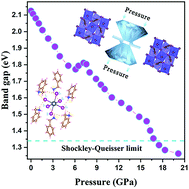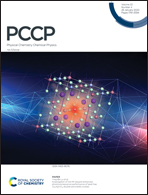Hydrogen-bond enhancement triggered structural evolution and band gap engineering of hybrid perovskite (C6H5CH2NH3)2PbI4 under high pressure†
Abstract
Hybrid organic–inorganic perovskites (HOIPs) have gained substantial attention due to their excellent photovoltaic and optoelectronic properties. Herein, we comprehensively investigate a typical two-dimensional (2D) hybrid perovskite (C6H5CH2NH3)2PbI4 to track its structural and band gap evolution applied by the maximum pressure of 27.2 GPa. Remarkably, an unprecedented band gap narrowing down to the Shockley–Queisser limit is observed upon compression to 20.1 GPa. Two phase transitions have been observed during this process: the ambient Pbca phase converts into the Pccn phase at 4.6 GPa and then undergoes an isostructural phase transition at 7.7 GPa. The Fourier Transform Infrared (FTIR) spectroscopy reveals that pressure-enhanced hydrogen bonding plays an important role in structural modifications and band gap variations. This work not only enables high pressure as a clean tool to tune the structure and band gap of hybrid perovskite, but also maps a pioneering route towards realizing ideal photovoltaic materials-by-design.

- This article is part of the themed collection: 2020 PCCP HOT Articles


 Please wait while we load your content...
Please wait while we load your content...